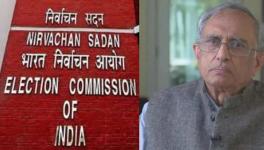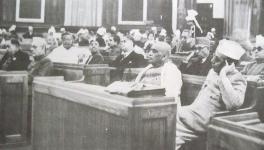Why Symbol of a Political Party is More Than Symbolic
The symbol of a recognised political party, although very symbolic in substance, has assumed a critical role in recent times, in the aftermath of the order of the Election Commission of India (ECI) to allot the symbols to a faction of the Shiv Sena group. Uddhav Thackeray, former chief minister of Maharashtra, has alleged the ECI is a “slave” of the Centre and vowed to finish the “thieves” who have been given the original Shiv Sena name and its bow-and-arrow symbol.
Earlier, in 2012, the ECI’s decision during the election to the Uttar Pradesh Assembly came under sharp criticism when it ordered covering statues of elephants in public parks—the elephant is the election symbol of the Bahujan Samaj Party. Symbols have attracted a fair share of criticism and satire and are often used to dramatise political issues. In the 1820s in the United States, the donkey, the symbol of the Democratic Party, was used to call its presidential candidate Andrew Jackson a “jack-ass” over his policies to remove federal deposits from the Bank of the United States.
Although political parties are an integral part of parliamentary democracies, the Constitution of India has not dealt with the formation and working of political parties, except in the Tenth Schedule, which deals with defections from parties. Part IV A of The Representation of the People Act (RPA) 1951 deals with the registration, fund-raising, and reporting of accounts of a party to the ECI.
Using its plenary powers under Article 324 of the Constitution, the ECI issued The Election Symbols (Reservation and Allotment) Order, 1968, to allot symbols to registered political parties for their exclusive use during elections for its contesting candidates. As per this quasi-judicial order, the ECI assumes the power to decide, in case of a split in a recognised political party, which of the rival sections or groups—or none of them—would get the symbols of the original and recognised political party.
Thus, symbols become very crucial for a recognised political party, as it is reserved to be used by all its candidates during elections. The symbol unites all party functionaries and supporters and thus forms one of the pillars of a political party. The RPA is silent about the symbol of a political party. Although symbolic for all practical purposes—in that a party’s symbol does not give any rights over its assets, infrastructure or offices—assumes criticality in case of a split. This is because the ECI’s decision gives a sort of legitimacy to one faction as the original recognised party—to the deprivation of the other.
The ECI, in resolving a dispute, does not decide which group represents the party but which group is that party. Its order, exercising its quasi-judicial powers, is justiciable. Hence, the petition of Uddhav Thackeray has been taken up by the Chief Justice of India for an urgent hearing before a Constitutional bench of five judges.
The crux of the debate is the basis on which the ECI grants the symbol to a faction of the party. The commission has issued orders on symbols in the past: during the split into two of the Congress party, when the faction led by former prime minister Indira Gandhi claimed the symbol; when former Tamil Nadu chief minister J Jayalalithaa’s faction claimed the AIADMK symbol; and when the former Uttar Pradesh chief minister Akhilesh Yadav faction claimed the symbol of the Samajwadi Party, and other cases. The commission’s orders have stood the test of judicial review, wherein the apex court has decided the test of majority should be the guiding principle.
Now, without prejudice to the Maharashtra case, the pertinent question arises whether the ECI has the wherewithal to ascertain if the majority of the members of a party support one faction. A political party is not only its legislative wing—the members of which the party sends to the Legislative Assembly or Parliament—but also its organisational wing, which decides and pursues the party’s aims and objectives. Although elected members operate as members of a political party in the legislature, they are bound by their’s party whip. That is, they cannot express a view in the legislature that is contrary to their party’s view, as conveyed through the party whip.
A political party is a broader organisation, formed as per its constitution and consisting of members who are represented through its organising committees, which are legally mandated to be filled up by members elected democratically by party members. It is settled law that the test of a majority has to be satisfied both in the party’s organising committees and legislative wing.
The ECI’s order has dispensed with the majority test in the organising committees of the Shiv Sena on the ground that the members of its organising committee were not democratically elected. The basis on which it formed this opinion is that the party amended its constitution in 2018 to provide for filling up the members of its organising committee, not through transparent elections. Also, as per the RPA, it is obligatory for a registered party to communicate all changes in its address and “any other material matters” to the Commission without delay. The said amendment of the party constitution of the Shiv Sena was not conveyed to the Commission.
Be that as it may, basic questions have to be settled by the court. One is whether the ECI has the power to ignore the test of majority in a party’s organising committees on the ground that its members were not democratically elected. Another is whether the ECI’s decision to depend wholly and exclusively on the test of a majority in the party’s legislative wing for the allotment of symbol to one faction is as per the law. Further, if the party violated the RPA by not reporting changes in its constitution, did the commission have any other recourse, such as withdrawing its recognition? Or has the ECI exercised its power fairly and reasonably when it decided to allot the party symbol in favour of one faction of the party? These are the broader questions of law the apex court must decide.
The author, a Supreme Court advocate, is a former Director-General of the Election Commission. The views are personal.
Get the latest reports & analysis with people's perspective on Protests, movements & deep analytical videos, discussions of the current affairs in your Telegram app. Subscribe to NewsClick's Telegram channel & get Real-Time updates on stories, as they get published on our website.
























